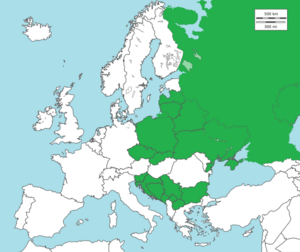List of Balto-Slavic languages facts for kids
The Balto-Slavic languages are a special group of languages. They are spoken by millions of people in Eastern Europe and parts of Central Europe. These languages are like cousins because they all come from a very old language that no one speaks anymore. This means they share many similar words and grammar rules.
Contents
Baltic Languages
The Baltic languages are spoken mostly around the Baltic Sea. There are two main living Baltic languages:
- Latvian: About 1.75 million people speak Latvian. It is the official language of Latvia.
- Lithuanian: Around 3 million people speak Lithuanian. It is the official language of Lithuania.
- Latgalian: This language is closely related to Latvian. About 200,000 people speak it.
West Slavic Languages
The West Slavic languages are spoken in Central Europe. They include some very well-known languages:
- Polish: This is a big language with about 55 million speakers. It is the official language of Poland.
- Czech: About 10.6 million people speak Czech. It is the official language of the Czech Republic.
- Slovak: Around 5.2 million people speak Slovak. It is the official language of Slovakia.
- Kashubian: This language is spoken by a smaller group of people in Poland. It is related to Polish.
- Sorbian: About 50,000 people speak Sorbian. It is spoken in parts of Germany.
South Slavic Languages
The South Slavic languages are spoken in the Balkan region of Southeast Europe.
- Serbo-Croatian: This is a group of very similar languages. About 21 million people speak them. They include:
- Bosnian
- Croatian
- Serbian
- Montenegrin
- Bulgarian: About 9 million people speak Bulgarian. It is the official language of Bulgaria.
- Slovene: Around 2.5 million people speak Slovene. It is the official language of Slovenia.
- Macedonian: Between 1.4 and 3.5 million people speak Macedonian. It is the official language of North Macedonia.
- Church Slavonic: This is a very old language. It is mostly used today in religious services.
East Slavic Languages
The East Slavic languages are spoken in Eastern Europe. They have the most speakers among the Slavic groups.
- Russian: This is one of the most widely spoken languages in the world. About 150 million people speak Russian as their first language. Many more speak it as a second language.
- Ukrainian: Around 45 million people speak Ukrainian. It is the official language of Ukraine.
- Belarusian: About 3.2 million people speak Belarusian. It is one of the official languages of Belarus.
- Rusyn: This language is spoken by a smaller group of people in several countries.
Languages That Are No Longer Spoken
Some languages from the Balto-Slavic family are now extinct. This means no one speaks them anymore. They give us clues about how modern languages developed.
Extinct Slavic Languages
- Proto-Slavic: This was the very old language that all Slavic languages came from.
- Old Church Slavonic: An early form of Slavic, used for religious texts.
- Knaanic: A Jewish language that was spoken in Central Europe.
- Old Novgorod dialect: A historical dialect spoken in the city of Novgorod.
- Old East Slavic: This language developed into modern East Slavic languages like Russian and Ukrainian.
- Ruthenian: A historical language spoken in parts of Eastern Europe.
- Polabian: This language was spoken in parts of Germany.
- Pomeranian: Only a small part of this language, Kashubian, is still spoken today.
Extinct Baltic Languages
- Curonian
- Old Prussian: This language was spoken in what is now northeastern Poland and Kaliningrad.
- Galindan
- Selonian
- Semigallian
- Sudovian
See also
- Outline of Slavic history and culture
- List of Slavic studies journals


